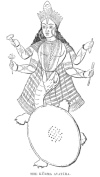
Sacred Texts Hinduism Index Previous Next


Hindu Mythology, Vedic and Puranic, by W.J. Wilkins, [1900], at sacred-texts.com
This incarnation was necessitated by the fact that the gods were in danger of losing their authority over the demons. In their distress they applied to Vishnu for help, who told them to churn the sea of milk that they might procure the Amrita, or water of life, by which they would be made strong, and promised to become the
tortoise on which the mountain Mandara as a churning stick should rest. As a full account of this operation has been already given when describing Lakshmi, who was one of its chief products, there is no necessity to repeat it here. A few additional particulars will be found in the following extract from the "Vishnu Purāna:"— *
"Hari having been entreated to help the gods, thus spoke: 'I will restore your strength. Do you act as I enjoin. Let all the gods and asuras cast all sorts of medicinal herbs into the sea of milk, and together churn the ocean for ambrosia, depending on my aid. To secure the assistance of the daityas, you must be at peace with them, and engage to give them an equal share of your associated toil; promising them that by drinking of the amrita . . . they shall become mighty and immortal. I will take care that the enemies of the gods shall not partake of the precious draught; they shall only share in the labour.'"
The gods entered into an arrangement with the asuras, and together they made the necessary preparations. " The assembled gods were stationed by Krishna at the tail of the serpent Vasuki (the churning rope), and the daityas and dānavas at its head and neck. Scorched by the flames emitted from his inflated hood, the demons were shorn of their glory; whilst the clouds, driven by his breath towards his tail, refreshed the gods by vivifying showers. In the midst of the milky sea, Hari himself, in the form of a tortoise, served as a pivot for the mountain, as it was whirled around. The holder of the mace and discus was present in other forms amongst the gods and demons, and assisted to drag the monarch of the serpent race; and in another vast body sat upon
the summit of the mountain. With one portion of his energy, unseen by gods and demons, he sustained the serpent king; and with another infused vigour unto the gods."

Click to enlarge
THE KŪRMA AVATĀRA.
Such is the account of this incarnation of Vishnu as taught by the Purānas; but in the earlier books, where the probable origin of this legend is found, it is Brahmā, and not Vishnu, that is said to have assumed the form
of a tortoise. In the "Satapatha Brāhmana" are these words: "Having assumed the form of a tortoise, Prajāpati (Brahmā) created offspring. That which he created, he made; " hence the word Kūrma. Kasyapa means tortoise; hence men say, "All creatures are descendants of Kasyapa. This tortoise is the same as Aditya." As the worship of Brahmā became less popular, whilst that of Vishnu increased in its attraction, the names, attributes, and works of the one deity appear to have been transferred to the other.
142:* Page 73.